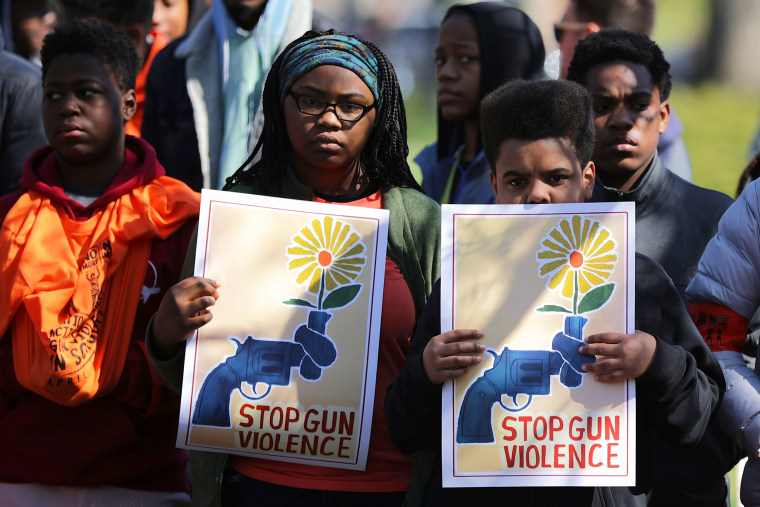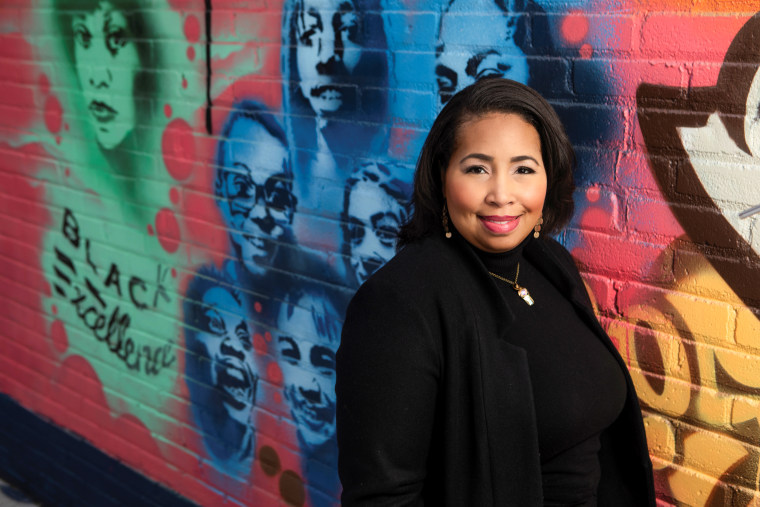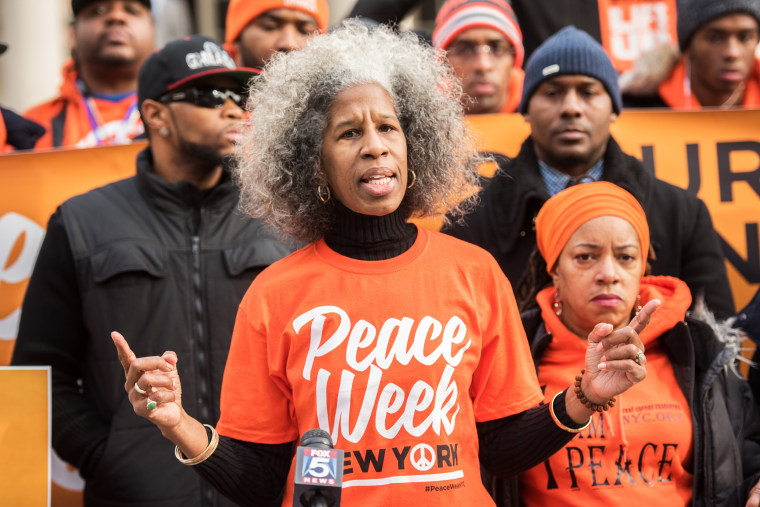Black Americans are facing a crisis of gun-related homicides, from personal disputes to mass shootings, according to figures released last week by the Centers for Disease Control and Prevention.
Gun deaths have reached their highest level in 25 years, and an outsize proportion of victims are Black, according to the report. Gun deaths were especially high among young Black men and boys ages 10 to 24, compared to white men and boys of similar ages.
The CDC’s figures were released days before a gunman killed 10 and injured three at a grocery store on Saturday in a Black neighborhood in Buffalo, New York. Eleven of the 13 victims were Black. An 18-year-old white man was arrested at the scene.
Anti-gun violence advocates and community groups said several factors are at play in this disparity in gun deaths, including racial hatred, lack of funding for gun violence prevention programs and disinvestment in Black communities — all of which were exacerbated by the pandemic. But that’s why these groups also say their work is more crucial than ever.

Organizers at LIFE Camp, an anti-violence and wellness organization in New York, are among the many advocates calling on officials to allocate more resources toward tackling gun violence and its aftermath on Black communities.
“We have to address the disease of violence and its spread,” Erica Ford, the founder of the group, told NBC News. “This is not an accident that only one community is impacted so viciously.”
Sasha Cotton, director of the Minneapolis Office of Violence Prevention, which responded with resources and services and partnered with community groups in the aftermath of George Floyd’s murder in 2020, said the most recent mass shooting in Buffalo is part of a broader trend.

“We’ve seen an increase around racially motivated gun violence in the last several years,” Cotton said, noting similar shootings targeting Latinos in Texas in 2019 and women of Asian descent in Atlanta last year. “At the end of the day, the convergence of trauma and access to guns is what creates the lack of safety, whether it’s personal, one-to-one or small group violence or the mass shooting tragedy like we saw in Buffalo this weekend.”
“Both of them are traumatic for the communities that are impacted. Both of them cause loss of life, and both of them have rippling effects,” she added.
‘That bullet destroyed that family’
Ford said community groups and officials must gain insight from previous episodes of violence to prevent future ones.
“The CDC laid these things out, but we have to do intentional strategic planning on the ground and investment on the ground,” she said. “So we show up different after we learn something.”
A stark example comes from a decade ago, when Lloyd Morgan, a 4-year-old Black boy, was struck by a stray bullet on a Bronx playground in 2012 during a memorial for another victim of violence near the same park.
“That bullet destroyed that family,” said Ford, whose organization worked with the relatives following the shooting. She added that prevention tactics after the initial fatal killing “could have saved that family.”
Ford said that since the first woman was attacked and killed near the park, community groups and city agencies should have worked together to mediate conflict between the individuals or redesign how events were held in the park to create a safer environment.
“Who are the individuals on both sides ... that we need to look at on that day, work with on that day, so that nothing else comes out of that pain that those folks were feeling for the first?” Ford said. “How do we look at working with public safety to make sure that we keep the two groups away from each other?”
‘Where are they getting the guns from?’
Cheryl Riviere, the managing director of community safety for Living Classrooms Foundation, a nonprofit anti-violence organization based in Baltimore, said that even as organizations intervene with social services, a flood of guns continues to come through the neighborhoods.
“We have kids who have guns that are from Afghanistan,” she said. “They may not even know how to get their meal, but they are able to access guns. Where are they getting these guns from?”
Earlier this year, Riviere said one of the team members of Safe Streets, the group’s community safety initiative, was shot and killed while mediating gun violence in a neighborhood.
“We’re still feeling it,” Riviere said. “He was out working, talking to one of his participants, trying to get them on the right track.”
Violence also comes with an economic cost, she said. To address this, Riviere proposed a boost in funding to improve infrastructure, including dilapidated roads and houses, that could entice more small businesses to come to the area and support the community.
“When you have communities with high gun violence, the likelihood of people wanting to reinvest or invest in that community lessens,” Riviere said. “You go in certain neighborhoods you have people … who are paid to clean up the blocks every day, and in communities that are plagued by gun violence, that’s not happening.”
Solutions to gun violence
To address the influx of guns on the streets and to help prevent mass shootings, Cotton proposed tighter gun control policies at the federal, state and local level. She also called on officials to ramp up investment for strategies that de-escalate and stop future violence.
“What our communities are needing is a comprehensive system, just like health care, that requires prevention, intervention, quarantine, aftercare,” Cotton said. “Until we really take that on seriously and use the resources that are available to fund all of those things we’re going to continue to see the same problems.”
Ford said the passage of the Build Back Better Act, which would provide robust funding, programs and services to the public, could help fill gaps in the lack of resources, including investments in youth, playgrounds and mental health care. (The Build Back Better Act passed in the House last November but has been stalled in the Senate.)
“There needs to be PeaceMobiles throughout the United States, so that we can really go in and work intentionally with individuals who are being impacted by trauma, who are being shot, whose families are losing loved ones,” said Ford, whose organization operates a peace bus in New York City, providing free access to wellness services.
Rana Ryan, a licensed clinical psychotherapist in Buffalo, said another gap is the lack of culturally competent mental health resources available on the ground. Many of her clients face additional stressors, she said, including a lack of transportation, cellular service and Internet connection, making it harder to connect to care.
“There’s not enough African Americans who are clinically trained in this field of trauma and social work to address the needs of that population, especially in Buffalo,” Ryan said. “We need more Black workers if you’re going to work in a Black community. It takes education and training to understand generational oppression.”
In Wisconsin, Debra Gillispie, the founder of Mothers Against Gun Violence in Milwaukee, proposed providing increased access to homeownership for working class populations along with job opportunities and counseling.
“Homeowners are invested in the community,” said Gillispie, who created the organization following the shooting death of her son. “We want to make sure our community is safe … and that we maintain or increase our property value and we have long term people in our community that are also invested.”
The Black trans community is also facing disproportionate rates of gun violence, with Black trans women comprising a majority of gun deaths. A 2020 report from Everytown for Gun Safety, a gun-control advocacy group, found that 75 percent of trans people killed in the U.S. were killed with a gun.
“We are seeing an increasing prevalence of intimate partner violence among the TGNC (transgender and gender nonconforming) community members that has not been properly addressed,” said Sean Ebony Coleman, the founder of Destination Tomorrow, an LGBTQ center in the Bronx and Atlanta. “Working to develop programs and services for TGNC people experiencing this form of violence is imperative.”
So far this year, six transgender and gender-nonconforming people across the U.S. have been killed in anti-trans violence; most of the victims were trans women of color, according to the Human Rights Campaign.
A focus on gun violence prevention strategies and more robust policies are critical, Cotton said, in creating a safer world.
“How many more losses of life do we have to sustain?” Cotton asked. “Whether it’s in our Black and brown communities, mass shootings, suicides. At the end of the day, they all lead to a loss of life and tragedy and guns are part of a problem that our communities and our societies just have not been willing to address.”

